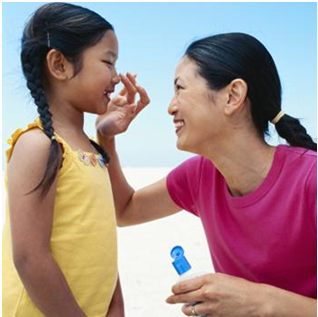Protect Your Skin! Sunscreen is In! By Our Student Pharmacist, Cambree Fillis.
With summer quickly approaching and copious sunscreen products starting to fill up the endcaps at many retail stores, it is important to understand which products are appropriate. Check out our endcap display at the end of this posting or stop in the store to find what you need.
What causes sunburn and what is my risk?
Sunburn is caused by exposure to ultraviolet radiation (UVR) from natural and artificial light sources. Ultraviolet radiation is made up of UVA and UVB rays. UVB rays are the main culprits of sunburn, but both rays can contribute to cosmetic concerns and cancer down the road.
The body’s natural protection from the sun is by a substance called melanin. The amount of melanin correlates to the pigmentation of the skin. Generally, the more melanin, the darker the skin color. Individuals with lighter skin tones have less melanin and are therefore at a higher risk of sunburn.
Additional risk factors for getting sunburn include:
- living in or vacationing in areas close to the equator or at high altitudes.
- spending time on sandy beaches or in water since UV rays are readily reflected off of those surfaces.
- Taking various medications that increase the sensitivity of our skin to the sun. Refer to the previous blog post to learn more about which medications tend to do this.
Why is it so important to prevent sunburn?
By preventing sunburn, you can prevent unnecessary pain and possible infection. You can also prevent the possible development of skin cancer and wrinkles in the future. One in five Americans develop skin cancer in their lifetime, and melanoma is one of the deadliest forms. However, if it is detected early enough it can be treated effectively. Use the ABCDEs of melanoma shown above as a visual guide for when to seek help from a medical professional.
How can I prevent sunburn?
Several mechanisms for preventing sunburn exist. Finding shade during the hours of 10:00 am and 2:00 pm when the sun’s rays are at their strongest is helpful. Or, seek shade from trees, umbrellas, and tents. Hats, too, may provide adequate protection for the face, head, ears, and neck, and lightweight long-sleeved shirts and pants may provide more full-body coverage. In addition, remember to protect your eyes with sunglasses while you’re outdoors. Lastly, sunscreen can, and should be, used in combination.
Sunscreens come in a variety of forms including sprays, lotions, gels, and wipes. When choosing a product it is important to consider the sun protection factor (SPF) and whether or not it protects against UVA and/or UVB rays.
According to the American Academy of Dermatology, sunscreen should have an SPF of 30 or greater and be broad-spectrum, meaning it protects against UVA and UVB rays. Water-resistant sunscreen is also recommended. A water resistant label ensures at least 40 minutes of protection while swimming and/or sweating. However, even if you are using water-resistant sunscreen, you should always re-apply every two hours or immediately after swimming and/or sweating.
What if I was unable to prevent the burn?
Treatments of sunburn are geared towards symptom management to relieve pain and swelling due to the burn. Nonsteroidal anti-inflammatory drugs (NSAIDs), including ibuprofen and naproxen, can be used to reduce pain and swelling. The use of lotions with Aloe, sprays with a local pain reliever, and cool compresses can also be used to relieve discomfort related to mild sunburns. Burns that result in blistering should be cleaned with mild soap and water, and then covered with the appropriate dressing. Severe sunburns, however, may require a visit to the emergency room.
Additional pointers to stay protected this summer include:
- Generously apply sunscreen 15 to 30 minutes before going out in the sun.
- Don’t forget your lips, ears, back, and tops of feet!
- Apply sunscreen even on cloudy days.
- Check expiration dates on all sunscreen products. Expired sunscreen may be less effective.
- If there is no expiration date, it is recommended to replace supplies every three years.
- Protect sunscreen from direct sun and excess heat if possible.
- Sunscreen has not been studied on children less than 6 months old. Protective clothing and avoidance of direct sun is recommended. A minimal amount may be applied to small areas including the child’s face and/or back of hands if needed.
Resources:
- American Academy of Dermatology. Defend! Catch! Take Action! How to be a Skin Cancer Hero. Accessed April 2019. 2019. file:///C:/Users/ Owner/Downloads/be-a-skin-cancer-hero-infographic.pdf.
- American Academy of Dermatology. Say Yes to Sun Protection Say No to Skin Cancer. Accessed April 2019. https://www.aad.org/public/spot-skin-cancer/learn-about-skin-cancer/prevent/say-yes-to-sun- protection.
- Young AR, et al. Patient education: Sunburn (Beyond the Basics). UpToDate. Wolters Kluwer. March 2019. https://www.uptodate.com/contents/sunburn-beyond-the-basics.
- Young AR, et al. Patient education: Sunburn prevention (Beyond the Basics). UpToDate. Wolters Kluwer. March 2019. https://www.uptodate.com/contents/sunburn-prevention-beyond-the-basics?topic Ref= 2730&source=see_link.




